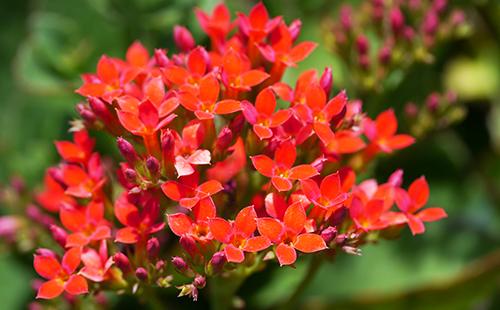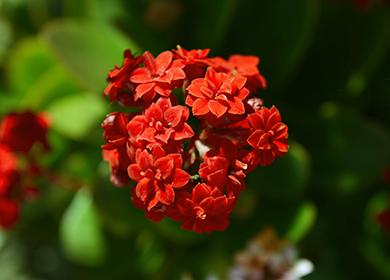The content of the article
Kalanchoe Blossfeld is a grassy succulent perennial. It belongs to the decorative-flowering plants of the family Crassulaceae. In the wild grows in Madagascar. One of the most common varieties of Kalanchoe for indoor cultivation.
Description and Features
Grows in the form of a small bush. The height usually does not exceed 30 cm. The leaves are small dark, fleshy with a glossy smooth surface. Compact sockets are formed. The length of the leaves is not more than 7 cm. The edges are globular, decorated with a reddish border.
During the flowering of Kalanchoe, Blossfeld produces long peduncles. Inflorescences are multiflowered, consist of 60 or more buds. The flowers are small, tubular, of various colors, are simple and double. Long flowering - from spring to autumn.
What to look for in the store
Any potted plants are recommended to be bought only in specialized stores. Choose them carefully, evaluate not only the general appearance, but also the condition of the plant. A healthy flower will take root more quickly and grow.
It is better to buy Kalanchoe Blossfeld at the end of winter, when the plant has already released flower arrows, but the buds have not yet blossomed. By buds, you can determine the color of the flowers, flowering will continue until the fall, subject to proper care. When buying, pay attention to the following points.
- Priming. The state of the root system depends on the quality of the soil. If the soil is dense, there are signs of mold, salt deposits, the root system could be affected.
- Leaves and Stems. Normally - uniform green, elastic, without spots and signs of rot.
- Pests. A thin cobweb, a whitish bloom, dots on flowers and leaves - all this can speak of a recent defeat by pests. Perhaps the flower was treated with insecticides in the store, but it is weakened.
- Leaves are pale, reaching up. The flower was kept in low light.
- Bush size. The bush is large, much higher than 30 cm. Foliage prevails, peduncles are few, inflorescences are poor. This happens with an excessive amount of growth stimulants.
Blossfeld Kalanchoe care after purchase
How to care for Blossfeld Kalanchoe after purchase? Kalanchoe Blossfeld easily adapts to new conditions of detention. But the intensity of its first flowering largely depends on the correctness of care after purchase.
- Quarantine. Immediately put next to other flowers of Kalanchoe is not necessary. Watch him a little. With the purchase of a new flower, there is always a risk of bringing home undetected pests in the store.
- Transfer. If the soil condition is unsatisfactory, you need to transplant Blossfeld's Kalanchoe immediately. In normal soil conditions, the transplant should be postponed until the end of flowering.
- Top dressing. In the first month, fertilizers do not need to be applied. Before the sale, Kalanchoe received them in abundance.
- Watering. The soil is kept barely wet. A period of mild drought facilitates adaptation and helps identify pests.
General content rules
Growing Kalanchoe Blossfeld in a pot is not particularly difficult. All flowering species of Kalanchoe require approximately the same care. It is enough to create favorable conditions and adhere to the basic rules.
- Lighting. The light is bright, diffused, without direct sunlight. In winter you can keep it on the southern windows, in summer it is better to rearrange it on the east side. It is considered a short day plant. The daylight hours are adjusted artificially.
- Temperature. Kalanchoe does not like heat and cold. The optimal range is from + 14 ° C to + 25 ° C. Raising or lowering the temperature beyond these limits negatively affects the flowering and condition of the plant.
- Humidity. Dry air Kalanchoe tolerates calmly. Spraying is only necessary to remove dust from the leaves. Avoid getting moisture on the flowers, immediately after irrigation, the leaves are wiped with a soft cloth. Maintenance in conditions of high humidity leads to the development of fungal diseases and decay.
- Watering. Often watering Kalanchoe Blossfeld is not necessary. The optimal watering schedule is twice a week in the warm season, twice a month in the cold. Before watering, check the soil moisture. The next watering is allowed only when the topsoil dries. Preference is given to lower watering through the pan. The remaining water from the sump is poured immediately after sufficient moisture in the soil.
- The soil. Planted in light soil with low acidity. You can use ready-made soil mixtures for succulents. The soil prepared at home is made up of sheet soil, turf, humus and sand. Adhere to equal proportions of components.
- Transfer. Strongly overgrown bushes are transplanted after flowering. Preference is given to the transshipment method - Kalanchoe is carefully removed from the old container, transferred to a new pot with a lump of earth. Free space is filled with fresh soil mixture.
- Top dressing. Fertilizers are applied year-round, simultaneously with watering. In summer, the intervals between dressings are two weeks, in the winter - a month. Use standard mineral complexes for succulents. With a weak formation of peduncles, you can feed phosphorus fertilizer.
Peduncle formation
Kalanchoe Blossfeld belongs to the decorative-flowering plants. Failure to comply with the basic rules of care, adverse conditions of detention lead to inhibition of the formation of peduncles. You can achieve regular flowering by adjusting the irrigation and lighting regime, stimulating the formation of peduncles, and proper care during flowering.
Why there are no buds ...
Blossfeld Kalanchoe does not bloom for various reasons. Sometimes a combination of factors immediately affects.
- Daylight hours. Too long or short. Kalanchoe Blossfeld will not bloom when daylight hours are less than eight or more than 12 hours.
- Irrigation. Kalanchoe does not like prolonged drying, waterlogging of the soil, high humidity.
- Excess fertilizer. Frequent top dressing, especially with a nitrogen content, leads to intensive foliage growth, lack of flowering.
- Pest. Insects weaken the plant, inhibit the laying of flower buds.
- Spacious pot. In a large pot, Kalanchoe directs forces to the development of the root system. Flowering is delayed.
... and how to stimulate
The first step to regular flowering is to adjust your care. Normalize the watering schedule, select a sufficiently lit place, in the summer, if possible, take it out to fresh air. According to the reviews of flower growers, the only way that surely makes Blanfeld’s Kalanchoe bloom is to artificially create a short daylight.
The daylight hours should be eight to ten hours. At five or six in the evening, Kalanchoe is covered with a cardboard box or put in a closet. At seven or eight in the morning they return to the windowsill. Repeat this procedure until the peduncles appear. Kalanchoe usually produces flower arrows after one and a half months of artificial reduction in daylight hours. This way you can stimulate flowering at any time of the year.
Optimal conditions in the process ...
Care for Kalanchoe Blossfeld during flowering is practically unchanged. To increase the flowering time, experienced gardeners recommend that you follow a number of rules.
- Temperature. Maintain a moderate temperature. Heat or cold can cause dropping buds.
- Watering. Regular, moderate, as the topsoil dries. Do not dry completely. Moisture should not fall on buds and blossoming flowers.
- Formation. Timely removal of wilted flowers stimulates the laying of new buds.
… and after
After the last flowers wither, a period of rest sets in - the Kalanchoe regains strength, prepares for a new wave of flowering. At this time, top dressing is temporarily stopped, watering is limited, the pot of Kalanchoe is rearranged in a cool place.
It is important to prune Blossfeld's Kalanchoe correctly. All wilted flower stalks are completely cut off. Crop deformed, heavily grown, ugly shoots. As new shoots grow, they are pinched to form a lush bush.

Vegetative propagation methods
Propagation of Blossfeld Kalanchoe is practiced in several ways. Seeds are sown only for new varieties. Existing plants are propagated vegetatively.
- Leafy cuttings. For rooting, cut a healthy leaf or use recently fallen leaves. Wet sand is poured into the container, a leaf is deepened slightly into it. The container is covered with a film, kept in a warm, shaded place until the roots appear.
- Stem cuttings. The best cuttings are the upper part of the stem. In water, Kalanchoe often rots even with the addition of activated carbon. It is better to root in wet sand or peat.
Seed breeding
Growing Kalanchoe from seeds is a time-consuming method. Seeds are sown on the surface of moist soil based on deciduous humus. They build an improvised greenhouse - they cover it with film or glass. Keep in a dark, warm place until germination. In the process, it is important to observe four rules.
- Several times a day, the shelter is removed for ventilation.
- Maintain stable soil moisture - overflow and drying out are not allowed.
- After the emergence of the shoots, the film is removed, the container is rearranged into the light.
- A pick is carried out one and a half months after the emergence of seedlings.
Frequent diseases
The two main problems of Blossfeld Kalanchoe are fungal diseases and rot.The predisposing factors in both cases are high humidity of air and soil. The table shows the most common diseases, their signs and methods of treatment.
Table - Diseases of Kalanchoe Blossfeld
| Disease name | Manifestations | Treatment methods |
|---|---|---|
| Phytophthora rot (fungus) | - Brown necrotic spots appear; - the plant wilt | - Stopping watering; - replacement of the topsoil with dry soil; - watering with Previkur, Profit Gold fungicide |
| Gray rot (fungus) | - Weeping spots with a gray coating appear; - the plant rots | - Trimming of the affected parts; - treatment with systemic fungicide "Fundazol", "Rovral" |
| Powdery mildew (fungus) | - There are spots with a whitish powdery coating; - leaves fall | - Spraying with drugs "Fundazol", "Topaz" |
| Stem rot | - Black watery spots are visible; - shoots die off | - Isolation of the plant; - treatment with drugs "Saprol", "Rovral"; - in case of severe defeat - destroy |
| Kalanchoe virus | - Old leaves become coarse, become ugly; - young leaves lose color | - Not subject to treatment - destroy |
| Ring spotting (virus) | - Light ring-shaped spots appear; - plant growth slows down | - Not subject to treatment - destroy |
Common pests
When kept in adverse conditions, Kalanchoe Blossfeld is susceptible to attack by pests. Take measures to destroy them immediately after the detection of even single insects. The table shows the most dangerous pests and ways to combat them.
Table - Pests of Kalanchoe Blossfeld
| Insect name | Signs of infection | Ways to fight |
|---|---|---|
| Multi-claw ticks | - The formation of brown scab; - hardening, curvature of leaves | - Processing with mineral oil; - spraying with fungicide "Lightning", "Vermitek", "Akarin" |
| Spider mites | - Yellow specks on the leaves; - discoloration and drying of large areas of leaves; - growth of deformed young shoots; - the appearance of the web | - Washing with soapy water; - spraying with fungicide "Lightning", "Vermitek", "Akarin" |
| Aphid | - yellowing of the leaves; - curly leaves; - sticky, sticky discharge | - Washing with soapy water; - treatment with any insecticides |
| Worms | - The appearance of white waxy discharge; - growth inhibition | - Spraying with mineral oil with sun protection |
Proper, systematic care for Blossfeld Kalanchoe is a guarantee of stable and friendly flowering. Lush hats of flowers will decorate the house for up to six months.

